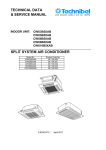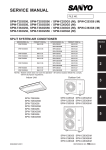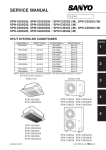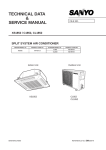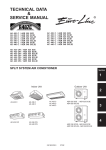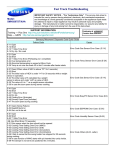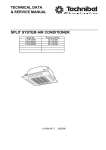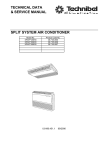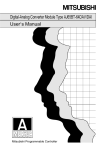Download TECHNICAL DATA & SERVICE MANUAL SPLIT SYSTEM AIR
Transcript
TECHNICAL DATA & SERVICE MANUAL INDOOR UNIT: ASR525CL ASR536CL ASR548CL SPLIT SYSTEM AIR CONDITIONER Model No. ASR525CL ASR536CL ASR548CL Product Code No. 387006100 387006101 387006102 0.8180.365.0 10/2004 • Ground the unit following local electrical codes. • The Yellow/Green wire cannot be used for any connection different from the ground connection. • Connect all wiring tightly. Loose wiring may cause overheating at connection points and a possible fire hazard. • Do not allow wiring to touch the refrigerant tubing, compressor, or any moving parts of the fan. • Do not use multi-core cable when wiring the power supply and control lines. Use separate cables for each type of line. IMPORTANT! Please read before installation This air conditioning system meets strict safety and operating standards. For the installer or service person, it is important to install or service the system so that it operates safely and efficiently. For safe installation and trouble-free operation, you must: • Carefully read this instruction booklet before beginning. • Follow each installation or repair step exactly as shown. • Observe all local, state and national electrical codes. • Pay close attention to all warning and caution notices given in this manual. •The unit must be supplied with a dedicated electrical line. When transporting Be careful when picking up and moving the indoor and outdoor units. Get a partner to help, and bend your knees when lifting to reduce strain on your back. Sharp edges or thin aluminium fins on the air conditioner can cut your fingers. WARNING When installing... This symbol refers to a hazard or unsafe practice which can result in severe personal injury or death. … In a ceiling Make sure the ceiling is strong enough to hold the unit-weight. It may be necessary to build a strong wooden or metal frame to provide added support. … In a room CAUTION Properly insulate any tubing run inside a room to prevent "sweating", which can cause dripping and water damage to walls and floors. This symbol refers to a hazard or unsafe practice which can result in personal injury or product or property damage. ... In moist or uneven locations Use a raised concrete base to provide a solid level foundation for the outdoor unit. This prevents damage and abnormal vibrations. If necessary, get help These instructions are all you need for most installation sites and maintenance conditions. If you require help for a special problem, contact our sale/service outlet or your certified dealer for additional instructions. ... In area with strong winds Securely anchor the outdoor unit down with bolts and a metal frame. Provide a suitable air baffle. In case of improper installation The manufacturer shall in no way be responsible for improper installation or maintenance service, including failure to follow the instructions in this document. ... In a snowy area (for heat pump-type systems) Install the outdoor unit on a raised platform that is higher then drifting snow. Provide snow vents. SPECIAL PRECAUTIONS When connecting refrigerant tubing • During installation, connect before the refrigerant system and then the wiring one; proceed in the reverse orden when removing the units. • Keep all tubing runs as short as possible. • Use the flare method for connecting tubing. • Apply refrigerant lubricant to the matching surfaces of the flare and union tubes before connecting them; screw by hand and then tighten the nut with a torque wrench for a leak-free connection. • Check carefully for leaks before starting the test run. WARNING When wiring ELECTRICAL SHOCK CAN CAUSE SEVERE PERSONAL INJURY OR DEATH. ONLY QUALIFIED, EXPERIENCED ELECTRICIANS SHOULD ATTEMPT TO WIRE THIS SYSTEM. NOTE: Depending on the system type, liquid and gas lines may be either narrow or wide. Therefore, to avoid confusion, the refrigerant tubing for your particular model is specified as narrow tube for liquid, wide tube for gas. • Do not supply power to the unit until all wiring and tubing are completed or reconnected and checked, to ensure the grounding. • Highly dangerous electrical voltages are used in this system. Carefully refer to the wiring diagram and these instructions when wiring. Improper connections and inadequate grounding can cause accidental injury and death. When servicing • Turn the power OFF at the main power board before opening the unit to check or repair electrical parts and wiring. • Keep your fingers and clothing away from any moving parts. • Clean up the site after the work, remembering to check that no metal scraps or bits of wiring have been left inside the unit being serviced. • Ventilate the room during the installation or testing the refrigeration system; make sure that, after the installation, no gas leaks are present, because this could produce toxic gas and dangerous if in contact with flames or heat-sources. 2 Table of Contents Page 4 4 7 10 1. SPECIFICATIONS 1-1 Unit specifications 1-2 Major Component specifications 1-3 Other Component specifications 2. DIMENSIONAL DATA 11 3. ELECTRICAL DATA 13 13 14 3-1 Electric Wiring Diagram 3-1 Schematic Diagram 15 15 16 4. FUNCTION 4-1 Room Temperature Control 4-2 Freeze Prevention 5. TROUBLESHOOTING 17 6. CHECKING ELECTRICAL COMPONENTS 29 29 30 30 31 6-1 Measurement of Insulation Resistance 6-2 Checking Continuity of Fuse on PCB Ass'y 6-3 Checking Motor Capacitor 6-4 Thermistor Characteristic Curve 3 1. SPECIFICATIONS 1-1 Unit Specifications ASR525CL Power source 220 - 240V ~ 50Hz Voltage rating 230V Performance Capacity Air circulation (High/Med./Low) Features Controls/Temperature controls Remote Controller Timer Fan speed Airflow direction Air Filter Operation sound Refrigerant tubing connections Refrigerant tube diameter Refrigerant Refrigerant control Dimensions & Weight Dimensions (include panel) Package dimensions Unit Ceiling panel Weight (include panel) Ceiling panel m³/h High/Med./Low Narrow tube Wide tube dB-A mm(in.) mm(in.) Height Width Depth Height Width Depth Volume Height Width Depth Volume Net Shipping Net Shipping mm mm mm mm mm mm m3 mm mm mm m3 kg kg kg kg 4 Cooling See catalogue with the requested matching 1140/1020/840 Microprocessor/ I.C. thermostat Wireless remote control unit ON/OFF 24 hours & Daily program, 1-hour OFF 3 and Auto Auto (Remote control) Washable, easy acces, long life (2500 hr.) 37/35/31 Flare type 6,35 (1/4) 15,88 (5/8) R407C Capillary tube 338 860 860 320 880 840 0,238 110 965 965 0,1 22 26 6 8 DATA SUBJECT TO CHANGE WITHOUT NOTICE ASR536CL Power source 220 - 240V ~ 50Hz Voltage rating 230V Performance Capacity Air circulation (High/Med./Low) Features Controls/Temperature controls Remote Controller Timer Fan speed Airflow direction Air Filter Operation sound Refrigerant tubing connections Refrigerant tube diameter Refrigerant Refrigerant control Dimensions & Weight Dimensions (include panel) Package dimensions Unit Ceiling panel Weight (include panel) Ceiling panel m³/h High/Med./Low Narrow tube Wide tube dB-A mm(in.) mm(in.) Height Width Depth Height Width Depth Volume Height Width Depth Volume Net Shipping Net Shipping mm mm mm mm mm mm m3 mm mm mm m3 kg kg kg kg 5 Cooling See catalogue with the requested matching 1920/1680/1320 Microprocessor/ I.C. thermostat Wireless remote control unit ON/OFF 24 hours & Daily program, 1-hour OFF 3 and Auto Auto (Remote control) Washable, easy acces, long life (2500 hr.) 42/39/35 Flare type 9,52 (3/8) 19,05 (3/4) R407C Capillary tube 368 1150 860 350 1170 840 0,35 110 1250 965 0,131 27 32 8 10 DATA SUBJECT TO CHANGE WITHOUT NOTICE ASR548CL Power source 220 - 240V ~ 50Hz Voltage rating 230V Performance Capacity Air circulation (High/Med./Low) Features Controls/Temperature controls Remote Controller Timer Fan speed Airflow direction Air Filter Operation sound Refrigerant tubing connections Refrigerant tube diameter Refrigerant Refrigerant control Dimensions & Weight Dimensions (include panel) Package dimensions Unit Ceiling panel Weight (include panel) Ceiling panel m³/h High/Med./Low Narrow tube Wide tube dB-A mm(in.) mm(in.) Height Width Depth Height Width Depth Volume Height Width Depth Volume Net Shipping Net Shipping mm mm mm mm mm mm m3 mm mm mm m3 kg kg kg kg 6 Cooling See catalogue with the requested matching 1920/1680/1320 Microprocessor/ I.C. thermostat Wireless remote control unit ON/OFF 24 hours & Daily program, 1-hour OFF 3 and Auto Auto (Remote control) Washable, easy acces, long life (2500 hr.) 42/39/35 Flare type 9,52 (3/8) 19,05 (3/4) R407C Capillary tube 368 1150 860 350 1170 840 0,35 110 1250 965 0,131 27 32 8 10 DATA SUBJECT TO CHANGE WITHOUT NOTICE 1-2 Major Component Specifications ASR525CL Controller PCB Part No. Controls CR-XR254GS Microprocessor Fan & Fan Motor Type Q'ty ……. Diameter Fan motor model…Q'ty No. Of poles…rpm (230 V, High) Running Amps Power input Coil resistance (Ambient temp. 20 °C ) Safety devices mm A W Ω Type Operating temp. Open Close °C °C µF VAC Run capacitor Panel Model Flap motor rating rpm nominal output coil resistance (25°C) W kΩ Dew proof heater Heat Exch. Coil Coil Rows Fin pitch face area Centrifugal fan 1…. Ø 443 SFG6X-41D6P…1 6 … 470 0,611 31,4 BRN-WHT: 170,3 WHT-VLT: 18,1 VLT-ORG: 43,2 ORG-YEL: 43,2 WHT-PNK: 83,5 YEL-BLK: 60,2 Internal thermal protector 130 ± 8 79 ± 15 4,5 440 ASG25SCE M2LB24ZA12 240 VAC 2,5 3 15,62 ± 15% 240 V, 26W Aluminium plate fin / Copper tube 2 1,5 mm 0,343 m2 DATA SUBJECT TO CHANGE WITHOUT NOTICE 7 ASR536CL Controller PCB Part No. Controls CR-XR254GS Microprocessor Fan & Fan Motor Type Q'ty ……. Diameter Fan motor model…Q'ty No. Of poles…rpm (230 V, High) Running Amps Power input Coil resistance (Ambient temp. 20 °C ) Safety devices mm A W Ω Type Operating temp. Open Close °C °C µF VAC Run capacitor Panel Model Flap motor rating rpm nominal output coil resistance (25°C) W kΩ Dew proof heater Heat Exch. Coil Coil Rows Fin pitch face area Centrifugal fan 1…. Ø 443 SFG6X-81A6P…1 6 … 530 0,765 38 BRN-WHT: 75,1 WHT-VLT: 6,7 VLT-ORG: 20,6 ORG-YEL: 27,4 WHT-PNK: 42,7 YEL-BLK: 58 Internal thermal protector 130 ± 8 79 ± 15 5 440 ASG3648E M2LB24ZA12 240 VAC 2,5 3 15,62 ± 15% 240 V, 26W Aluminium plate fin / Copper tube 2 1,5 mm 0,556 m2 DATA SUBJECT TO CHANGE WITHOUT NOTICE 8 ASR548CL Controller PCB Part No. Controls CR-XR254GS Microprocessor Fan & Fan Motor Type Q'ty ……. Diameter Fan motor model…Q'ty No. Of poles…rpm (230 V, High) Running Amps Power input Coil resistance (Ambient temp. 20 °C ) Safety devices mm A W Ω Type Operating temp. Open Close °C °C µF VAC Run capacitor Panel Model Flap motor rating rpm nominal output coil resistance (25°C) W kΩ Dew proof heater Heat Exch. Coil Coil Rows Fin pitch face area Centrifugal fan 1…. Ø 443 SFG6X-81A6P…1 6 … 530 0,871 51,9 BRN-WHT: 75,1 WHT-VLT: 6,7 VLT-ORG: 20,6 ORG-YEL: 27,4 WHT-PNK: 42,7 YEL-BLK: 58 Internal thermal protector 130 ± 8 79 ± 15 6 440 ASG3648E M2LB24ZA12 240 VAC 2,5 3 15,62 ± 15% 240 V, 26W Aluminium plate fin / Copper tube 2 1,5 mm 0,556 m2 DATA SUBJECT TO CHANGE WITHOUT NOTICE 9 1-3 Other Component Specifications Trasformer Rating Primary Secondary Capacity Ω Coil resistance Thermal cut-off temp. Thermistor ( Coil sensor ) Resistance ΚΩ Thermistor ( Room sensor TH1) Resistance Drain pump Model Rating ΚΩ ATR-II215TA VAC 230V, 50Hz 10,6V - 0.93A 7 VA (WHT-WHT): 96,5 (BRN-BRN): 0,8 (at 20°C) 150°C PBC-41E-S14 -10 °C 23,7 ± 5% -5 °C 18,8 ± 5% 0 °C 15,0 ± 5% 5 °C 12,1 ± 5% 10 °C 9,7 ± 5% 15 °C 8,0 ± 5% KTEC-35-S6 0 °C 16,5 ± 5% 5 °C 12,8 ± 5% 10 °C 10,0 ± 5% 20 °C 6,3 ± 5% 30 °C 4,0 ± 5% 40 °C 2,7 ± 5% 45 °C 2,2 ± 5% 50 °C 1,8 ± 5% 55 °C 1,5 ± 5% PJV-1434A 230V 12W 500 mm / 400 cc/min. Voltage Input Total head / capacity Safety float switch Model Contact rating FS-0218-102 DC 5V - 50W 10 2. DIMENSIONAL DATA ASR525CL 5 261 221 292 232 X-view 100 339 7 124 59 124 6 157 48 30 2 12 25 860 500 12 100 776 368 7 124 9 12 2 221 225 12 776 Air intake grille Air outlet Refrigerant liquid line [D. 9.52 (In case of 25 type, use the tube connector.)] Refrigerant gas line D. 12.7: 9, 12 type Drain connection Power supply entry For discharge duct For fresh air intake 9 Suspension bolt mounting 8 Panel center 377 X 820 (Ceiling opening) 566 (Suspention bolt pitch) 860 500 124 1 4 820 (Ceiling opening) 757 (Suspention bolt pitch) 308 3 182 Units: mm 11 ASR536CL ASR548CL 124 291 232 59 6 292 X-view 100 339 7 5 244 157 124 182 30 338 2 12 25 790 2 8 12 1066 1150 513 9 124 8 249 12 12 180 12 244 776 Panel center 522 500 3 757 (Suspention bolt pitch) X 1110 (Ceiling opening) 856 (Suspention bolt pitch) 860 48 820 (Ceiling opening) 1 4 124 Air intake grille Air outlet Refrigerant liquid line (D.9.52) Refrigerant gas line (D.19.05) Drain connection Power supply entry For discharge duct For fresh air intake 9 Suspension bolt mounting 3. ELECTRICAL DATA 3-1 Electric Wiring Diagram DPH IND LAMP ASSY LM 7 YEL WHT GRY BLK SWITCH ASSY 1 2 3 1 1 2 1 2 1 2 3 2P (RED) COIL 2P (YEL) ROOM 3P (WHT) SW ASSY 7 7P (WHT) W/LESS CONNECTOR 4P(WHT) GRY BLK YEL WHT BRN RED ORG S 1 2 3 4 P 1 2 3 4 BLK BLK BLK BLK TH1 (COIL) TH2 (ROOM) 1 1 3 1 3 3P (RED) DPH 3P (GRN) LM CONTROLLER (CR-XR254GS) PRY 2P (WHT) SEC 2P (WHT) DP 3P (BLU) 1 3 5 1 2 1 2 1 3 FS FM 7P (WHT) 3P (RED) COM M H L 1 3 3P (WHT) 49FMI 1 3 5 7 1 3 BRN E SUP 5P (WHT) 4 TERMINAL PLATE(4P) TO OUTDOOR UNIT POWER SUPPLY P DP S TR FS 1 2 3 4 5 6 7 8 9 1 2 3 4 5 6 7 8 9 GRN/YEL GRN/YEL P S 3 PNK PNK BRN BRN BLK ORG YEL VLT ORG WHT VLT WHT GRY GRY GRY GRY CONNECTOR 9P(WHT) BLK BLK BLK BLK BRN BRN 2 WHT WHT WHT 1 BRN RED GRN/YEL RC FMI GRN/YEL EARTH TERMINAL EARTH TERMINAL 13 EARTH TERMINAL 3-2 Schematic Diagram CR-XR254GS CONTROLLER 4P-2 2 1 1 RY06 RY04 3 TR RY01 H 3 2 RY02 RY03 RY08 RY05 3 3 M 5 1 1 7 7 1 2 3 1 2 SW 3 IND RY02 L 3 RY03 7 FS 1 RY04 2 4 6 5 3 4 RY05 DPH LM DP 9 3 8 1 TH1 1 FMI 4P-4 RY06 2 49FMI 5 2 RY01 1 1 3 TH2 RC 1 2 1 1 1 COIL RY08 1 4P-1 1 F01 (3.15A) SYMBOLS DESCRIPTION FMI INDOOR FAN MOTOR 49FMI INDOOR MOTOR THERMAL PROTECTOR RC RUNNING CAPACITOR F01 FUSE DP DRAIN PUMP DPH DEW PROOF HEATER LM AUTO LOUVER MOTOR TR POWER TRANSFORMER RY01-RY06, RY08 AUXILIARY RELAY FS FLOAT SWITCH TH1 THERMISTOR (INDOOR COIL) TH2 ROOM THERMISTOR CR-X254GS INDOOR CONTROLLER IND INDICATOR LAMP ASSY SW SWITCH ASSY TERMINAL PLATE CONNECTOR TERMINAL 14 ROOM 4. FUNCTIONS 4-1 Room temperature control Room temperature control is obtained by cycling the compressor ON and OFF under control of the room temperature sensor in the remote control unit. The room temperature (and other information) is transmitted every 5 minutes by the remote control unit to the controller in the indoor unit. Signal from remote control unit 5 minutes set temp. 5 minutes 5 minutes 5 minutes 5 minutes 5 minutes 5 minutes Thermo. OFF Thermo. ON Thermo. OFF Thermo. ON Thermo. ON Thermo. ON Thermo. OFF T+1 °C T °C More than 5 minutes Compressor ON OFF 5 minutes 3 minutes ON OFF 3 seconds Outdoor fan Indoor fan ON OFF Room temp. ON OFF 3 seconds ON OFF ON OFF Set speed The control circuit will not attempt to turn the compressor ON until the compressor has been OFF for at least 3 minutes. To protect the compressor from stalling out when trying to start against the high side refrigerant pressure, the control circuit has a built-in automatic time delay to allow the internal pressure to equalize. As a protective measure, the control circuit switches the compressor OFF not before than 5 minutes of compressor operation. Thermo. ON : When the room temperature is above T + 1°C (T°C is set temperature). Compressor ON Thermo. OFF : When the room temperature is equal to or below set temperature T°C. Compressor OFF 15 4-2 Freeze Prevention This function prevents freezing of the indoor heat exchange coil. When the compressor has been running for 6 minutes or more and the temperature of the indoor heat exchange coil falls below –0.8°C, the control circuit stops the compressor for at least 3 minutes. The compressor does not start again until the temperature rises above 8°C or 6 minutes has elapsed. Thermo. OFF Thermo. ON Room temp. T+1 ° C Set temp. T ° C Indoor heat exch. coil temp. More than 6 minutes 6 minutes –0.8 ° C More than 6 minutes Compressor Indoor fan ON More than 6 minutes OFF ON ON Set speed OFF Set speed 16 ON 5. TROUBLESHOOTING (1) Check before and after troubleshooting Many problems may occur because of wiring or power supply problems, and so you should check these areas first. Problems here can cause incorrect results in some of the other tests, and so they should be remedied first. 1. Check power supply wiring (a) Single-phase Check that the power supply wires are correctly connected to terminal No. 1 through No. 4 on the 4P terminal plate on the indoor unit and L and N on the 6P terminal on the outdoor unit. (b) 3-phase Check that the power supply wires are correctly connected to terminal No.1 through No. 4 on the 4P terminal plate on the indoor unit and L1 through L3 and N on the 8P terminal on the outdoor unit. 2. Check the inter-unit wiring Check that the inter-unit control wires (AC 220 - 240 V Line voltage) are correctly connected between the indoor unit and outdoor unit. Single-phase outdoor unit Indoor Unit 3-phase outdoor unit Outdoor Unit Indoor Unit Outdoor Unit B B 1 1 1 1 2 2 2 2 Ground 4 Ground 4 Inter-Unit Wiring (Line voltage) L N A 4 Power supply L 4 Inter-Unit Wiring (Line voltage) N L1 A Power supply L1 L2 L2 L3 L3 N N Ground 0611_X_S Ground 3. Check the power supply Check that the voltage is within the specified range ( ±10% of the rating). Check that power is supplied. WARNING If the following troubleshooting must be done with the power being supplied, take care not to touch any uninsulated live parts that will given an ELECTRIC SHOCK. 4. Check the lead wires and connectors in indoor and outdoor units. Check that the sheaths of the lead wires are not damaged. Check that the lead wires are firmly connected to the terminal plate. Check that the wiring has been performed correctly. 5. Reference • Condition of general cooling operation (Thermo. ON) SWEEP..................ON Indoor fan speed....HIGH 17 (2) Air conditioner does not operate 1. Circuit breaker trips (or fuse blows). (a) When the circuit breaker is set to ON, it trips immedialely. • There is a possibility of ground fault. • Check insulation resistance. If the resistance value is 1M½ or less, insulation is defective. (Example) Earth Remove power supply cords from terminal plate in outdoor unit. • Check insulation resistance of power supply cords. + Earth *Set the circuit breaker to OFF. 1 + + Interunit power line 3 + L1 L2 L3 N 2 Outdoor Indoor unit unit 4 5 1 1 Circuit 6 breaker 7 2 2 4 8 4 Power 3 3 Interunit supply power line cords + + + + 4 1 Indoor unit 1 2 3 4 + + + + 3 + Power supply cords 2 + + Circuit breaker Outdoor unit 5 1 6 2 3 4 + L N + + 1 NO Rewire OK 2 Remove inter-unit power line from terminal plate in outdoor unit. • Check insulation resistance of outdoor unit. NO Insulation of outdoor unit is defective. • Check insulation resistance of electrical parts in outdoor unit. Insulation of indoor unit is defective. • Check insulation resistance of electrical parts in indoor unit. OK 3 Remove inter-unit power line from terminal plate in indoor unit. • Check insulation resistance of indoor unit. NO OK Inter-unit power lines is defective. Rewire 18 (b) Circuit breaker trips in several minutes after turning the air conditioner on. • There is a possibility of short circuit. • Check capacity of circuit breaker. Replace it with a suitable one. (= larger capacity) NO Is capacity of circuit breaker sufficient ? • Check resistance of outdoor fan motor winding. • Check resistance of compressor motor winding. • Check resistance of louver motor winding. 2 A. Neither indoor unit nor outdoor unit runs. No power is supplied • Check power supply. Is power being supplied to outdoor unit ? B. Circuit breaker is tripped. Reset the breaker. Power failure. Wait for power to be restored or consult power supply company. NO Check remote control unit. • Try to run both indoor and outdoor units with another remote control unit. OK Other remote control unit is defective. 19 C. Check “Operation selector” switch in the indoor unit. • Has “Operation selector” switch been set to ON position ? IND. LAMP Ass’y or P.C.B. Ass’y in the indoor unit is defective. YES NO Set “Operation selector” switch to ON. Neither unit runs. Switch Ass’y or P.C.B. Ass’y in the indoor unit is defective. D. Check compressor motor protectors. a) High pressure switch (63PH) Disconnect the socket from the 2P (WHT) connector. Check the continuity between the No.1 and No.2 poles of the socket. • Check high pressure switch. Is high pressure switch actuated ? (63PH) YES • Is outdoor heat exchanger coil dirty or are there obstruction near air suction inlet of outdoor unit ? Clean heat exchanger coil or remove obstructions. YES NO • Check if outdoor fan rotates. Refer to “Only outdoor fan does not run.” b) Compressor motor overcurrent relay • Check compressor motor overcurrent relay. (51C) Is it actuated ? NO Refer to “CHECKING ELECTRICAL COMPONENTS (Electro magnetic contactor)”. YES Consult power supply company and restore voltage to normal value. • Check power supply voltage. YES Is voltage 90% of rated voltage or less? NO 90% of rated voltage or more. • Following causes may be considered. Locked rotor of compressor. Overcharged refrigerant. Insufficient air for outdoor unit ventilation. Obstruction in front of outdoor unit. 20 E. Check the auxiliary relay. (1Y or 2Y) • Check coil resistance of auxiliary relay. (1Y or 2Y) F. Check the indoor fan motor thermal protector (49FMI) • Disconnect the socket from the 9P (WHT) connector. • Check the continuity between No. 8 and No.9 poles of the 9P socket. No continuity. Thermal protector (49FMI) is actuated. • Check fan rotation. Rotate the fan gently once or twice by hand. Fan cannot be rotated. OK • Check fan motor capacitor. G. Check fan casing for foreign matter on inside. Remove foreign matter or repair. Fan motor burnout or foreign matter in bearing. Repair or replace. Check the fuse on the P.C.B. Ass’y in the indoor unit. • Check fuse on P.C.B. Ass'y in indoor unit for continuity. • Check resistance of louver motor winding. (LM) OK When the fuse blows. • Check transformer. (TR) OK • Check resistance of indoor fan motor winding. (FMI) • Check coil of compressor motor magnetic contactor. (52C) OK • P.C.B. Ass'y is defective. OK 21 (3) Outdoor unit does not run. A. Check the COOL/FAN selector switch in the remote control unit. • Is COOL/FAN selector switch NO set to COOL ? B. Set to COOL. Check the set temperature. Try to lower set temperature using temperature setting button “COOLER”. YES • Set “Operation selector” switch to TEST in indoor unit. Outdoor unit runs. Is room temperature too low ? NO • Try to run both indoor and outdoor units with another remote control unit. OK Other remote control unit is defective. (Room sensor in remote control unit is defective.) C. Outdoor unit is abnormal. a) Check the power supply wiring • Check negative phase relay. (47C) Is it actuated ? NO Rewire power supply cords. 22 b) Check the compressor motor thermal protector (49C) • Check compressor motor thermal protector. (49C) Is temperature of compressor abnormally high ? YES Insufficient refrigerant gas. NO Compressor is defective. • Check compressor motor magnetic contactor. (52C) (Only the outdoor fan does not run.) D. Check the indoor unit P.C.B. • Check P.C.B. Ass’y. • Check voltage between terminals No.2 and No.4 on terminal plate. No voltage appears. P.C.B. Ass’y is defective. 23 Charge refrigerant gas. (4) Indoor unit does not run. The indoor fan and louver motor do not run. P.C.B. Ass’y is defective. (5) Some parts fail to operate. (1) Only indoor fan does not run. • Check fan rotation. Rotate fan gently once or twice by hand. Fan cannot be rotated. • Check resistance of fan motor winding. OK • Check fan motor capacitor. OK P.C.B assy is defective. (2) Only louver motor does not run. • Check resistance of louver motor winding. OK P.C.B. Ass’y or remote control unit is defective. 24 Check fan casing for foreign matter on inside. Remove foreign matter or repair. Fan motor burnout or foreign matter in bearing. Repair or replace. (6) Outdoor fan does not run. • Check fan rotation. Rotate fan gently once or twice by hand. Fan cannot be rotated. • Check fan casing for foreign matter on the inside. Remove foreign matter or repair. • Fan motor burnout or foreign matter in bearing. Repair or replace. • Check resistance of fan motor winding. OK • Check fan motor capacitor • Check continuity between terminals on compressor motor magnetic contactor. (7) Outdoor fan speed is not switched from High to Low even when the outdoor temperature falls below 25.5°C. • Check thermostat (23S). • Check coil resistance of auxiliary relay. (1Y) (8) Compressor does not run. • Check compressor motor capacitor. OK • Check resistance of compressor motor winding. OK • Check compressor motor overload relay. OK • Check continuity between terminals R-U, and then S-V on the magnetic contactor. 25 NG Replace magnetic contactor. (9) Poor cooling Check position of remote control unit. • Does cool air from air conditioner reach remote control unit directly ? • Is wide tube between indoor unit and outdoor unit insulated ? Change position of remote control unit. YES Insulate wide tube and then execute taping with narrow tube. NO YES • Measure temperatures of suction and discharge air of indoor unit. Temperature difference Possibility of is small. insufficient refrigerant. Charge refrigerant Temperature difference between suction and discharge air is large enough (approx. 10 deg. or more). • Check clogging of air filter. • Is fan speed set to LOW ? Air filter is clogged. Set fan speed to either HIGH or MEDIUM. YES • Review cooling load estimate, if performance of air conditioner is normal. (10) Clean filter. Reduce cooling load or replace the unit with higher cooling capacity. Excessive cooling. • Set temperature is too low. • Is remote control unit placed where it can detect room temperature properly ? Set temperature to higher value using temperature setting button of remote control unit. YES NO Change position of remote control unit. 26 (11) PCB for "SCL" models 1 2 3 S002 LED1 LED2 POW 1 S001 D005 S002 (Capacity Code) 25 type 36 type 48 type 1 OFF ON ON 2 OFF OFF ON 3 OFF OFF OFF Meaning of LED indication POW Light Light LED1 Off Flash LED2 Off Light D005 Light Light Light Light Off Off Light Light Light Off Cause of trouble Normal state High pressure switch is activated, Outdoor fan thermal protector activated, Outdoor coil thermistor is open or short Low pressure switch is activated Negative phase, Defective phase 27 (12) Defective Sensor. 1. Indoor (heat exchanger) coil temp. Sensor is defective. (a) Open (=No continuity in sensor) Compressor and outdoor fan repeatedly go ON for 10 minutes and OFF for 6 minutes when sensor opens. (b) Short “Freeze Prevention” does not operate when dehumidified water is frozen on the indoor coil. 2. Room temp. Sensor (in the remote control unit) is defective. (a) Open (=No continuity in sensor) Neither the outdoor fan nor compressor runs. (b) Short The outdoor fan and compressor do not stop. — Excessive cooling. 28 6. CHECKING ELECTRICAL COMPONENTS 6-1 Measurement of Insulation Resistance power plug (Local supply) Ground The insulation is in good condition if the resistance exceeds 1MΩ probe Insulation tester NOTE 6-1-1. Power supply wires The shape of the power plug may differ from that of the air conditioner which you are servicing. Clamp the grounding terminal of the power plug with a lead clip of the insulation resistance tester and measure the resistance by placing a probe on both the two power terminals. (fig.1) Fig. 1 Terminal plate Then, also measure the resistance between the grounding and other power terminals. (fig.1) Probe 6-1-2. Indoor Unit Clamp a metallic part of the unit with the lead clip of the insulation resistance tester and measure the resistance by placing a probe on each terminal screw where power supply lines are connected on the terminal plate. (fig.2) Clip Copper tube or metallic part Insulation tester Fig. 2 6-1-3. Outdoor Unit Clamp an aluminium plate fin or copper tube with the lead clip of the insulation resistance tester and measure the resistance by placing a probe on each terminal screw on the terminal plate. (fig.2) Note that the ground line terminal should be skipped for the check. Probe Clip Copper tube or metallic part 6-1-4. Measurement of Insulation Insulation tester Resistance for Electrical Parts Disconnect the lead wires of the desired electric part from terminal plate, capacitor, etc. Similary disconnect the connector. Then measure the insulation resistance. (fig.3 and 4) From fan motor, compressor and other parts Metallic part NOTE: Refer to electric wiring diagram Fig. 3 Probe Clip If the probe cannot enter the poles because the hole is too narrow then use a probe with a thinner pin. Insulation tester Fig. 4 29 6-2 Checking Continuity of Fuse on PCB Ass'y Fuse Remove the PCB Ass'y from the electrical component box. Then pull out the fuse from the PCB Ass'y. (fig.5) PCB Ass’y Check for continuity using a multimeter as shown in fig.6 Fig. 5 Fuse Fig. 6 6-3 Checking Motor Capacitor Remove the lead wires from the capacitor terminals, and then place a probe on the capacitor terminals as shown in fig.7. Observe the deflection of the pointer, setting the resistance measuring range of the multimeter to the maximum value. Multimeter The capacitor is "good" if the pointer bounces to a great extent and then gradually returns to its original position. The range of deflection and deflection time differ according to the capacity of the capacitor. Compressor motor capacitor Fan motor capacitor Fig. 7 30 6-4 Thermistor Characteristic Curve 1 1 Room temp. sensor (KTEC-35) Coil sensor (PBC-41E) 40 35 10 30 Resistance (kn ) Resistance (kn ) 9 8 7 6 5 4 25 20 15 10 3 5 2 0 –20 1 –15 –10 –5 0 5 Temperature (°C) 10 15 20 25 30 35 40 Temperature (°C) 31 10 15 20 Via Varese, 90 - 21013 Gallarate - Va - Italy Tel. +39 0331 755111 - Fax +39 0331 776240 www.argoclima.it
































